.
Griechische Kunst: Die Opferung von Iphigenia und der Schleier des Timanthes
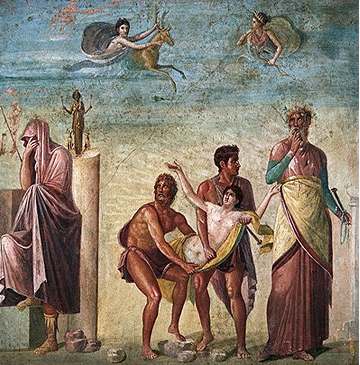
The Sacrifice of Iphigenia, a 1st Century AD Roman copy of a 4th Century BC painting by Timanthes, discovered at Pompeii, and now in the Museum at Naples
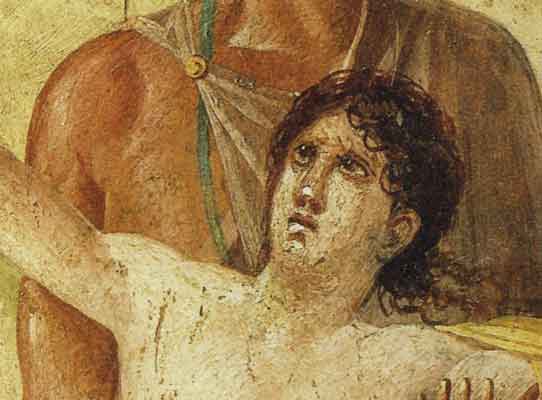
Detail of Iphigenia
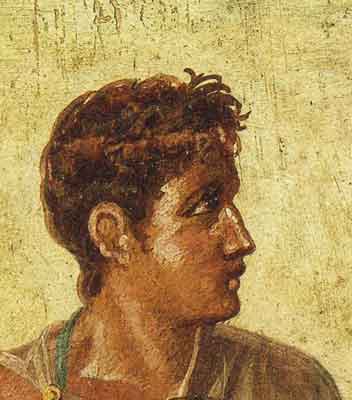
Detail of Menelaos
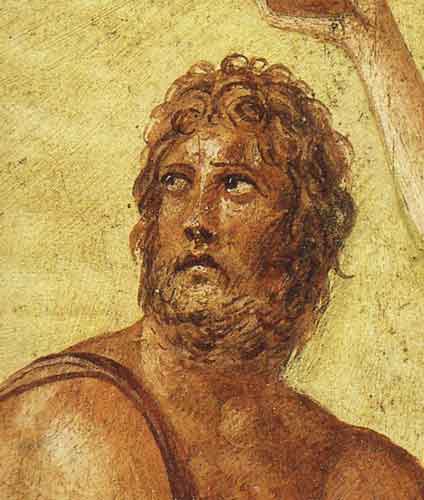
Detail of Odysseus
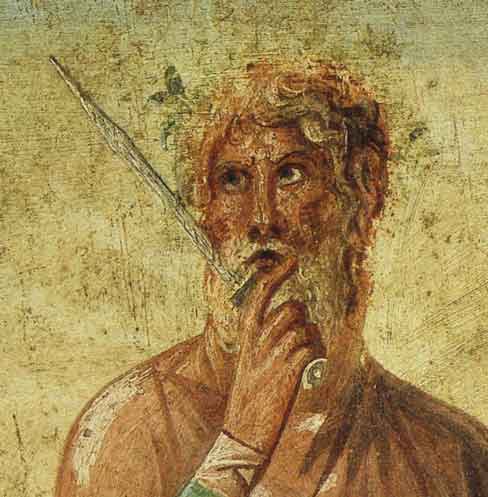
Detail of Calchas
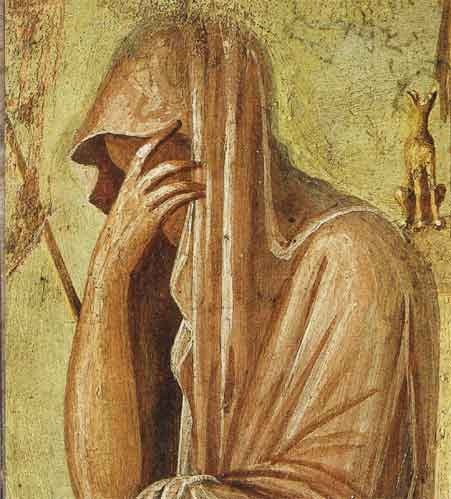
Detail of Agamemnon
...the picture to which all our accounts refer is the grief exhibited in varying degrees by the bystanders. The countenance of Calchas was sorrowful; that of Ulysses still more so; that of Menelaus displayed an intensity of distress which the painter could not outdo; Agamemnon, therefore, was represented with his face covered by his mantle, his attitude alone suggesting the father's poignant anguish. The description is interesting as illustrating the attention paid in this period to the expression of emotion. Timanthes was in spirit akin to Scopas. There is a Pompeian wall- painting of the sacrifice of Iphigenia, which represents Agamemnon with veiled head and which may be regarded, in that particular at least, as a remote echo of Timanthes's famous picture. F.B. Tarbell A History of Greek Art.
..but the emotional climax was the figure of Agamemnon himself, whose face was covered by a veil as he performed the sacrifice: as his emotions were not explicitly revealed, the viewer was left to imagine them in all their unbearable intensity. The picture thus succeeded in representing what it did not represent; in acknowledging the limits of art, it transcended them. Antiquity and the Middle Ages, Chapter 1
Timanthes of Cythnus or Sicyon, a Greek painter of the 4th century BC. Like all other painters none of his works survived. Cicero (Brutus, xviii.70) listed him among the painters who used a four-colour palette. Timanthes defeated with The Sacrifice of Iphigenia Kolotes of Teos in a competition.
He also defeated Parrhasios in a competition on Samos (Pliny, XXXV.64, 71, 73–4). Parrhasios painting showed Ajax, who according to a story in the Aethiopis and Little Iliad was defeated by Odysseus in the competition for the arms of Achilles. When Timanthes obtained the first prize Parrhasios said that Ajax has suffered a second indignity.
Other works
- A painting in which satyrs measure a sleeping Cyclops’ thumb with a thyrsus in order to suggest his size.
- The Death of Palamedes, which Alexander the Great admired at Ephesos;
- A Hero, a work in the Temple of Peace at Rome.
An interesting story from a catholic website:
... After several years the teacher’s efforts seemed to have paid off when Timanthes painted an exquisite work of art. Unfortunately, he became so enraptured with the painting that he spent days gazing at it. One morning when he arrived to admire his work, he was shocked to find it blotted out with paint. Angry, Timanthes ran to his teacher, who admitted he had destroyed the painting. “I did it for your own good. That painting was retarding your progress. Start again and see if you can do better.” Timanthes took his teacher’s advice and produced Sacrifice of Iphigenia, which is regarded as one of the finest paintings of antiquity.
How much close is this copy to the original? Iphigenia's skin is white, probably she was the whole time in Agamemnon's house whereas all men around were exposed to the Greek Sun. This work look similar to a Byzantine Icone where the persons and nature (here very minimalistic) are not shown realistically. It is surprising that whereas the Greek sculptures were so realistic and anatomically perfect this is not the case for persons in paintings.
Iphigenia at Aulis, Iliad 2
Who amongst us, if he were to attempt in reality to represent a celebrated work of Apelles or Timanthus, such as Pliny describes them, but would produce something absurd, or perfectly foreign to the exalted greatness of the ancients? Each one, relying on his own powers, would produce some wretched, crude, unfermented stuff, instead of an exquisite old wine, uniting strength and mellowness, outraging those great spirits whom I endeavour reverently to follow, satisfied, however, to honour the marks of their footsteps, instead of supposing—I acknowledge it candidly—that I can ever attain to their eminence even in mere conception, Rubens
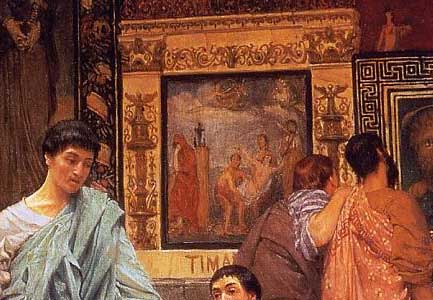
The Sacrifice of Iphigenia is shown in the painting "Collection of Pictures at the Time of Augustus" of Sir Lawrence Alma-Tadema (here a detail)
German Reports
Jammer ward in Betrübnis gemildert. Und wo diese Milderung nicht stattfinden konnte, wo der Jammer ebenso verkleinernd als entstellend gewesen wäre,--was tat da Timanthes? Sein Gemälde von der Opferung der Iphigenia, in welchem er allen Umstehenden den ihnen eigentuemlich zukommenden Grad der Traurigkeit erteilte, das Gesicht des Vaters aber, welches den allerhöchsten hätte zeigen sollen, verhüllete, ist bekannt, und es sind viel artige Dinge darüber gesagt worden. Er hatte sich, sagt dieser, in den traurigen Physiognomien so erschöpft, dass er dem Vater eine noch traurigere geben zu können verzweifelte. Er bekannte dadurch, sagt jener, dass der Schmerz eines Vaters bei dergleichen Vorfällen über allen Ausdruck sei. Ich für mein Teil sehe hier weder die Unvermögenheit des Künstlers, noch die Unvermögenheit der Kunst. Mit dem Grade des Affekts verstärken sich auch die ihm entsprechenden Züge des Gesichts; der höchste Grad hat die allerentschiedensten Züge, und nichts ist der Kunst leichter, als diese auszudrücken. Aber Timanthes kannte die Grenzen, welche die Grazien seiner Kunst setzen. Er wusste, dass sich der Jammer, welcher dem Agamemnon als Vater zukam, durch Verzerrungen äussert, die allezeit hässlich sind. Soweit sich Schönheit und Würde mit dem Ausdrucke verbinden liess, so weit trieb er ihn. Das Hässliche wäre er gern übergangen, hätte er gern gelindert; aber da ihm seine Komposition beides nicht erlaubte, was blieb ihm anders übrig, als es zu verhüllen?--Was er nicht malen durfte, liess er erraten. Kurz, diese Verhüllung ist ein Opfer, das der Künstler der Schönheit brachte. Sie ist ein Beispiel, nicht wie man den Ausdruck über die Schranken der Kunst treiben, sondern wie man ihn dem ersten Gesetze der Kunst, dem Gesetze der Schönheit, unterwerfen soll. Gotthold Ephraim Lessing Laokoon oder über die Grenzen der Malerei und Poesie
Sacrifice of Iphigenia. Apulian red figure volute krater (375-350 BC), British Museum. (Perseus Project)
Old and Modern Versions of the Sacrifice of Iphigenia
REFERENCES
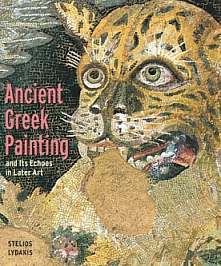
Stelios Lydakis, Ancient Greek Painting and Its Echoes in Later Art-, 304 pages (June 2004) Publisher: Getty Publishing ISBN: 0892366834
| Ancient Greece
Science, Technology , Medicine , Warfare, , Biographies , Life , Cities/Places/Maps , Arts , Literature , Philosophy ,Olympics, Mythology , History , Images Medieval Greece / Byzantine Empire Science, Technology, Arts, , Warfare , Literature, Biographies, Icons, History Modern Greece Cities, Islands, Regions, Fauna/Flora ,Biographies , History , Warfare, Science/Technology, Literature, Music , Arts , Film/Actors , Sport , Fashion --- |

